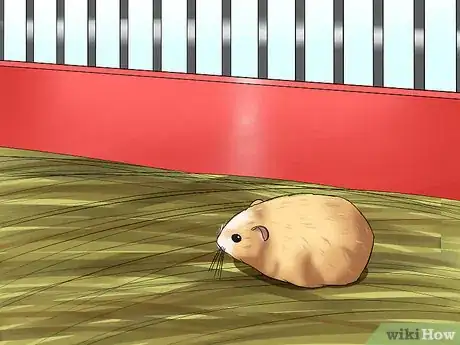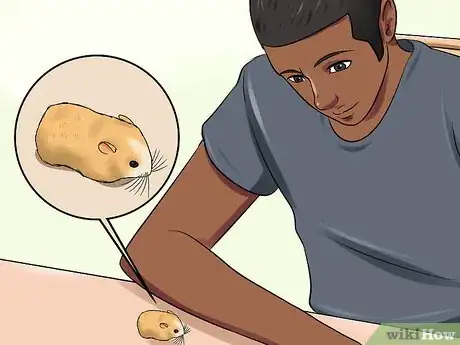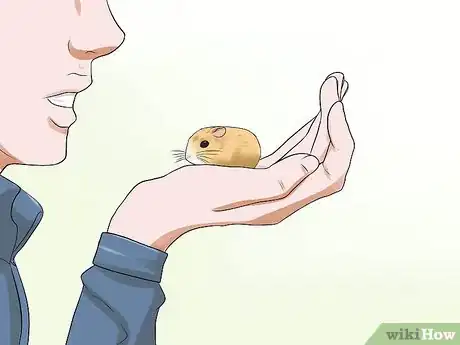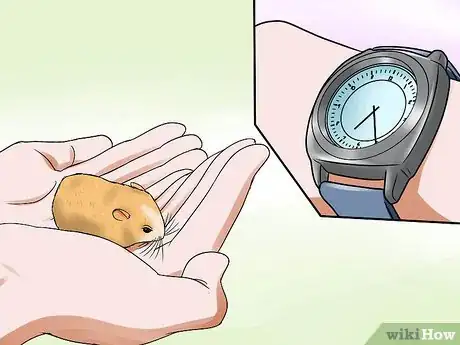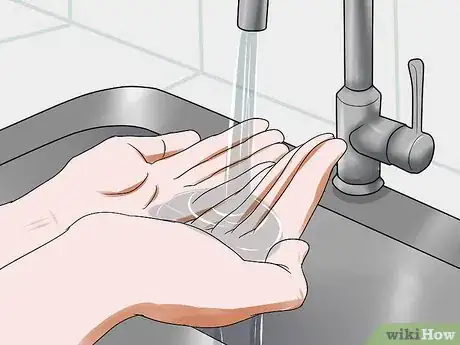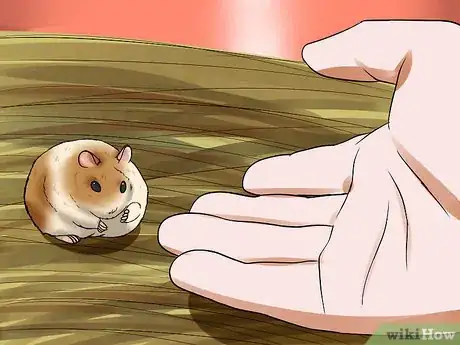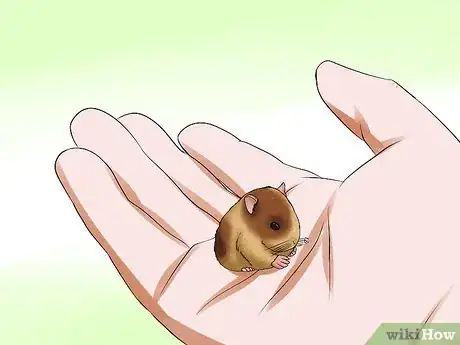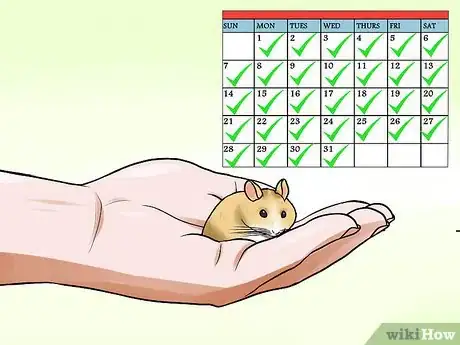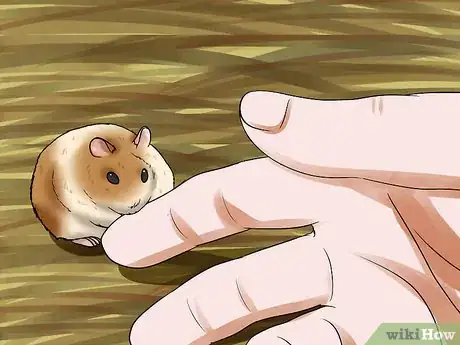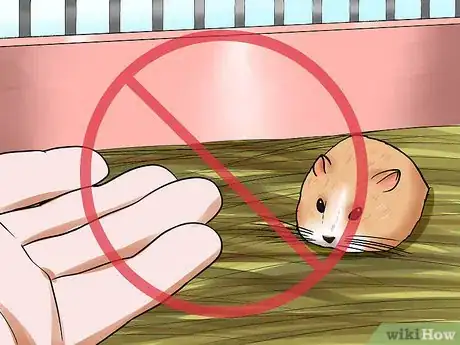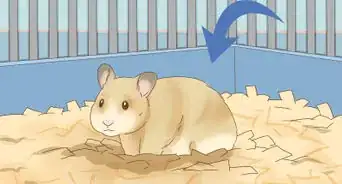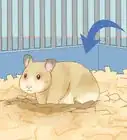This article was co-authored by Pippa Elliott, MRCVS. Dr. Elliott, BVMS, MRCVS is a veterinarian with over 30 years of experience in veterinary surgery and companion animal practice. She graduated from the University of Glasgow in 1987 with a degree in veterinary medicine and surgery. She has worked at the same animal clinic in her hometown for over 20 years.
wikiHow marks an article as reader-approved once it receives enough positive feedback. In this case, 92% of readers who voted found the article helpful, earning it our reader-approved status.
This article has been viewed 119,686 times.
Of the different types of dwarf hamsters (Campbell’s Russian Dwarf, Siberian Winter White, Roborovski), the Campbell’s Russian Dwarf makes the most popular pet.[1] Regardless of which type of dwarf hamster you have, they can all be tamed in the same way. Taming your dwarf hamster by holding him will help him be more friendly toward you, your family, and your friends.[2]
Steps
Getting Your Dwarf Hamster Used to You
-
1Let your dwarf hamster get used to his new environment. Dwarf hamsters look cute and cuddly, so you may want to hold your dwarf hamster right away. However, when you bring him home, he will need some time to get used to his cage. Give him a day or so to explore his environment and learn where things are in his cage. The more comfortable he is in his cage, the easier it will be for you to tame him.
- During this time, your dwarf hamster will also start learning your activities and movements around your home.
-
2Spend quiet time with your dwarf hamster. As your dwarf hamster is adjusting to you and his cage, spend time near his cage without interacting with him. For example, sit by his cage and watch TV or read a book. He should be comfortable with your calm and quiet presence before you start taming him.Advertisement
-
3Talk to your dwarf hamster. Once your dwarf hamster has settled in for a few days, start talking to him so he can get used to your voice. If you have a Russian dwarf hamster, talking to him will be very important, since he can’t see very well. When he knows your voice, he will be less likely to bite you when you pick him up.[3] Even if you don’t have a Russian dwarf hamster, your hamster will appreciate hearing the sound of your voice.
- When you talk to him, use a quiet and gentle voice.
Holding Your Dwarf Hamster
-
1Pick a good time to tame your dwarf hamster. Hamsters are nocturnal animals, meaning they are active at night. Choose a time later in the day, such as after dinner, when he is most likely to be awake. If you notice he is just waking up, give him about 15 minutes to be awake before trying to hold him.[4]
- If your dwarf hamster is sleeping, do not wake him up. If you do, he may be startled, think you are a threat, and try to bite you. Wait until he wakes up on his own.
-
2Wash your hands. Before you handle your dwarf hamster, wash your hands to remove any food scents. If your hamster smells food on your hands, he will think your hands are food and nibble on them. Use unscented soap to wash your hands.
-
3Lower your hands into your dwarf hamster's cage. Make a cup with your hands and slowly lower them into the cage. Speak to him as you lower your hands so he knows you are there and are not a threat.[5] Do not make any sudden movements or loud noises as you place your hands in his cage—this could startle him.[6]
- If your dwarf hamster is not readily walking onto your hands, consider putting some tasty treats in your hands to lure him to you.
- If treats don’t work, try using a scoop or a large serving spoon. Hold the item on the cage floor and let him walk onto it (don’t scoop him up). After you lift him out of the cage, transfer him to your hands.
-
4Lift your dwarf hamster up and let him explore you. When your dwarf hamster is nestled comfortably in your hands, slowly lift him up towards you. If you can, turn his body in your hands so he is facing you. Looking at you will help him feel less disoriented and scared about being lifted up.
- When you have him out of the cage, let him crawl on you. Exploring you will help your dwarf hamster feel more comfortable with you.[7] Be as still as you can while he climbs and crawls on you.
- Consider sitting or lying down so he can crawl on you more easily.
-
5Hold your dwarf hamster each day. Taming your dwarf hamster requires daily practice. Hold him a few times a day for 5 minutes each time.[8] With daily practice, your dwarf hamster will become more tame and easier to handle.
- Consider holding him at the same time each day. That way, he knows when to expect you.
Learning Taming Tips
-
1Learn the difference between biting and nibbling. Your dwarf hamster may bite or nibble on your hands as you tame him. A dwarf hamster will bite if he feels threatened or scared. He may also bite if he’s bored in his cage or not feeling very well.[9] Nibbling is a dwarf hamster’s way of testing and exploring things in its environment.
- Your dwarf hamster’s bite wouldn’t be enough to cause bleeding, but it could startle you.[10] A nibble would feel lighter than a bite.
-
2React properly if your dwarf hamster bites you. If your dwarf hamster bites you, blow in his face. This puff of air will be unpleasant to him but won't hurt him. He’ll get the message not to bite you anymore. Even if the bite startles you, do not drop him—the fall could injure him.[11]
- Putting some more toys in his cage, such as empty toilet paper or paper towel rolls, can relieve his boredom and possibly stop the biting behavior.
- If extra toys or blowing in his face are not stopping the biting, take him to your vet for a checkup.[12]
-
3Do not stick your hand in your dwarf hamster’s cage. Russian dwarf hamsters can be very territorial. If you have a Russian dwarf hamster, he may have a strong reaction to your hand in his cage and try to bite it, especially if he doesn't know you're nearby. Be extra careful when putting your hands in his cage.
- Your hand will look huge compared to his small body size. He will see your hand as a threat to his territory.[13]
Warnings
References
- ↑ http://hamsterific.com/dwarf-hamsters/
- ↑ http://russiandwarfhamster.org/tame-russian-dwarf-hamsters-beginners-guide-to-success/
- ↑ http://netvet.wustl.edu/species/hamsters/phodopus.txt
- ↑ http://russiandwarfhamster.org/tame-russian-dwarf-hamsters-beginners-guide-to-success/
- ↑ http://netvet.wustl.edu/species/hamsters/phodopus.txt
- ↑ http://russiandwarfhamster.org/tame-russian-dwarf-hamsters-beginners-guide-to-success/
- ↑ http://russiandwarfhamster.org/tame-russian-dwarf-hamsters-beginners-guide-to-success/
- ↑ http://russiandwarfhamster.org/tame-russian-dwarf-hamsters-beginners-guide-to-success/
- ↑ http://russiandwarfhamster.org/tame-russian-dwarf-hamsters-beginners-guide-to-success/
- ↑ http://netvet.wustl.edu/species/hamsters/phodopus.txt
- ↑ http://netvet.wustl.edu/species/hamsters/phodopus.txt
- ↑ http://russiandwarfhamster.org/tame-russian-dwarf-hamsters-beginners-guide-to-success/
- ↑ http://russiandwarfhamster.org/tame-russian-dwarf-hamsters-beginners-guide-to-success/
- ↑ http://russiandwarfhamster.org/tame-russian-dwarf-hamsters-beginners-guide-to-success/
- ↑ http://russiandwarfhamster.org/tame-russian-dwarf-hamsters-beginners-guide-to-success/
- ↑ http://russiandwarfhamster.org/tame-russian-dwarf-hamsters-beginners-guide-to-success/
- ↑ http://www.hammysworld.com/index.php?p=dwarfhamsters
- ↑ http://netvet.wustl.edu/species/hamsters/phodopus.txt
- ↑ http://russiandwarfhamster.org/tame-russian-dwarf-hamsters-beginners-guide-to-success/
About This Article
Before you try to tame your dwarf hamster, give it a day or so to get used to its new environment, then hang out near its cage watching TV or reading a book for a few days. Once your hamster is comfortable with your presence, introduce your hand into the cage, but don’t try to pick up the hamster right away. Also, avoid holding your hand so it’s hovering over the hamster, as this will make it think you’re a predator. After your hamster becomes comfortable with your hand in its cage, you can gently scoop it up from underneath to hold it. For tips from our Veterinary co-author on how to safely hold your dwarf hamster, read on!
